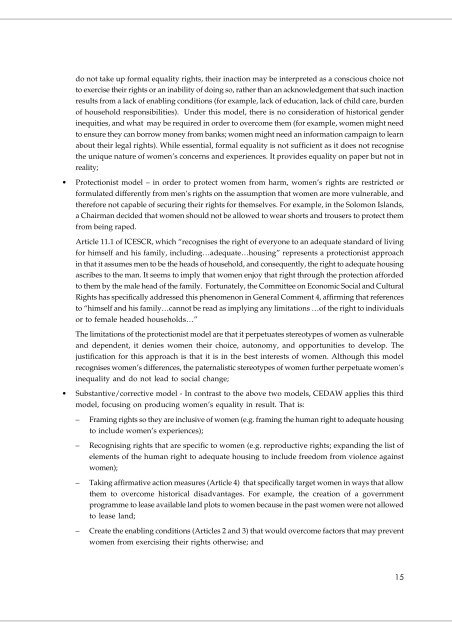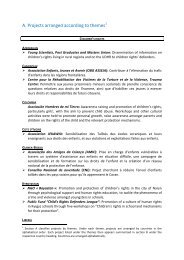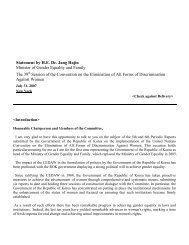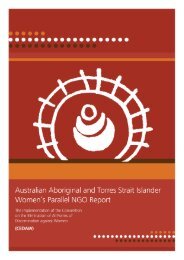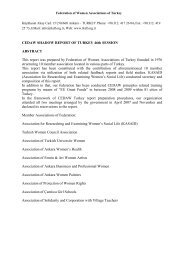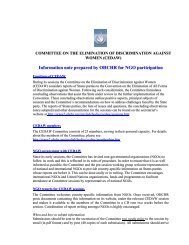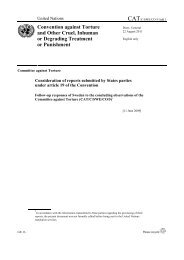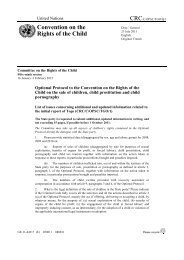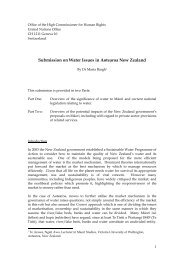Report - Office of the High Commissioner on Human Rights
Report - Office of the High Commissioner on Human Rights
Report - Office of the High Commissioner on Human Rights
- No tags were found...
You also want an ePaper? Increase the reach of your titles
YUMPU automatically turns print PDFs into web optimized ePapers that Google loves.
do not take up formal equality rights, <str<strong>on</strong>g>the</str<strong>on</strong>g>ir inacti<strong>on</strong> may be interpreted as a c<strong>on</strong>scious choice not<br />
to exercise <str<strong>on</strong>g>the</str<strong>on</strong>g>ir rights or an inability <str<strong>on</strong>g>of</str<strong>on</strong>g> doing so, ra<str<strong>on</strong>g>the</str<strong>on</strong>g>r than an acknowledgement that such inacti<strong>on</strong><br />
results from a lack <str<strong>on</strong>g>of</str<strong>on</strong>g> enabling c<strong>on</strong>diti<strong>on</strong>s (for example, lack <str<strong>on</strong>g>of</str<strong>on</strong>g> educati<strong>on</strong>, lack <str<strong>on</strong>g>of</str<strong>on</strong>g> child care, burden<br />
<str<strong>on</strong>g>of</str<strong>on</strong>g> household resp<strong>on</strong>sibilities). Under this model, <str<strong>on</strong>g>the</str<strong>on</strong>g>re is no c<strong>on</strong>siderati<strong>on</strong> <str<strong>on</strong>g>of</str<strong>on</strong>g> historical gender<br />
inequities, and what may be required in order to overcome <str<strong>on</strong>g>the</str<strong>on</strong>g>m (for example, women might need<br />
to ensure <str<strong>on</strong>g>the</str<strong>on</strong>g>y can borrow m<strong>on</strong>ey from banks; women might need an informati<strong>on</strong> campaign to learn<br />
about <str<strong>on</strong>g>the</str<strong>on</strong>g>ir legal rights). While essential, formal equality is not sufficient as it does not recognise<br />
<str<strong>on</strong>g>the</str<strong>on</strong>g> unique nature <str<strong>on</strong>g>of</str<strong>on</strong>g> women’s c<strong>on</strong>cerns and experiences. It provides equality <strong>on</strong> paper but not in<br />
reality;<br />
• Protecti<strong>on</strong>ist model – in order to protect women from harm, women’s rights are restricted or<br />
formulated differently from men’s rights <strong>on</strong> <str<strong>on</strong>g>the</str<strong>on</strong>g> assumpti<strong>on</strong> that women are more vulnerable, and<br />
<str<strong>on</strong>g>the</str<strong>on</strong>g>refore not capable <str<strong>on</strong>g>of</str<strong>on</strong>g> securing <str<strong>on</strong>g>the</str<strong>on</strong>g>ir rights for <str<strong>on</strong>g>the</str<strong>on</strong>g>mselves. For example, in <str<strong>on</strong>g>the</str<strong>on</strong>g> Solom<strong>on</strong> Islands,<br />
a Chairman decided that women should not be allowed to wear shorts and trousers to protect <str<strong>on</strong>g>the</str<strong>on</strong>g>m<br />
from being raped.<br />
Article 11.1 <str<strong>on</strong>g>of</str<strong>on</strong>g> ICESCR, which “recognises <str<strong>on</strong>g>the</str<strong>on</strong>g> right <str<strong>on</strong>g>of</str<strong>on</strong>g> every<strong>on</strong>e to an adequate standard <str<strong>on</strong>g>of</str<strong>on</strong>g> living<br />
for himself and his family, including…adequate…housing” represents a protecti<strong>on</strong>ist approach<br />
in that it assumes men to be <str<strong>on</strong>g>the</str<strong>on</strong>g> heads <str<strong>on</strong>g>of</str<strong>on</strong>g> household, and c<strong>on</strong>sequently, <str<strong>on</strong>g>the</str<strong>on</strong>g> right to adequate housing<br />
ascribes to <str<strong>on</strong>g>the</str<strong>on</strong>g> man. It seems to imply that women enjoy that right through <str<strong>on</strong>g>the</str<strong>on</strong>g> protecti<strong>on</strong> afforded<br />
to <str<strong>on</strong>g>the</str<strong>on</strong>g>m by <str<strong>on</strong>g>the</str<strong>on</strong>g> male head <str<strong>on</strong>g>of</str<strong>on</strong>g> <str<strong>on</strong>g>the</str<strong>on</strong>g> family. Fortunately, <str<strong>on</strong>g>the</str<strong>on</strong>g> Committee <strong>on</strong> Ec<strong>on</strong>omic Social and Cultural<br />
<strong>Rights</strong> has specifically addressed this phenomen<strong>on</strong> in General Comment 4, affirming that references<br />
to “himself and his family…cannot be read as implying any limitati<strong>on</strong>s …<str<strong>on</strong>g>of</str<strong>on</strong>g> <str<strong>on</strong>g>the</str<strong>on</strong>g> right to individuals<br />
or to female headed households…”<br />
The limitati<strong>on</strong>s <str<strong>on</strong>g>of</str<strong>on</strong>g> <str<strong>on</strong>g>the</str<strong>on</strong>g> protecti<strong>on</strong>ist model are that it perpetuates stereotypes <str<strong>on</strong>g>of</str<strong>on</strong>g> women as vulnerable<br />
and dependent, it denies women <str<strong>on</strong>g>the</str<strong>on</strong>g>ir choice, aut<strong>on</strong>omy, and opportunities to develop. The<br />
justificati<strong>on</strong> for this approach is that it is in <str<strong>on</strong>g>the</str<strong>on</strong>g> best interests <str<strong>on</strong>g>of</str<strong>on</strong>g> women. Although this model<br />
recognises women’s differences, <str<strong>on</strong>g>the</str<strong>on</strong>g> paternalistic stereotypes <str<strong>on</strong>g>of</str<strong>on</strong>g> women fur<str<strong>on</strong>g>the</str<strong>on</strong>g>r perpetuate women’s<br />
inequality and do not lead to social change;<br />
• Substantive/corrective model - In c<strong>on</strong>trast to <str<strong>on</strong>g>the</str<strong>on</strong>g> above two models, CEDAW applies this third<br />
model, focusing <strong>on</strong> producing women’s equality in result. That is:<br />
– Framing rights so <str<strong>on</strong>g>the</str<strong>on</strong>g>y are inclusive <str<strong>on</strong>g>of</str<strong>on</strong>g> women (e.g. framing <str<strong>on</strong>g>the</str<strong>on</strong>g> human right to adequate housing<br />
to include women’s experiences);<br />
– Recognising rights that are specific to women (e.g. reproductive rights; expanding <str<strong>on</strong>g>the</str<strong>on</strong>g> list <str<strong>on</strong>g>of</str<strong>on</strong>g><br />
elements <str<strong>on</strong>g>of</str<strong>on</strong>g> <str<strong>on</strong>g>the</str<strong>on</strong>g> human right to adequate housing to include freedom from violence against<br />
women);<br />
– Taking affirmative acti<strong>on</strong> measures (Article 4) that specifically target women in ways that allow<br />
<str<strong>on</strong>g>the</str<strong>on</strong>g>m to overcome historical disadvantages. For example, <str<strong>on</strong>g>the</str<strong>on</strong>g> creati<strong>on</strong> <str<strong>on</strong>g>of</str<strong>on</strong>g> a government<br />
programme to lease available land plots to women because in <str<strong>on</strong>g>the</str<strong>on</strong>g> past women were not allowed<br />
to lease land;<br />
– Create <str<strong>on</strong>g>the</str<strong>on</strong>g> enabling c<strong>on</strong>diti<strong>on</strong>s (Articles 2 and 3) that would overcome factors that may prevent<br />
women from exercising <str<strong>on</strong>g>the</str<strong>on</strong>g>ir rights o<str<strong>on</strong>g>the</str<strong>on</strong>g>rwise; and<br />
EXECUTIVE SUMMARY 15


